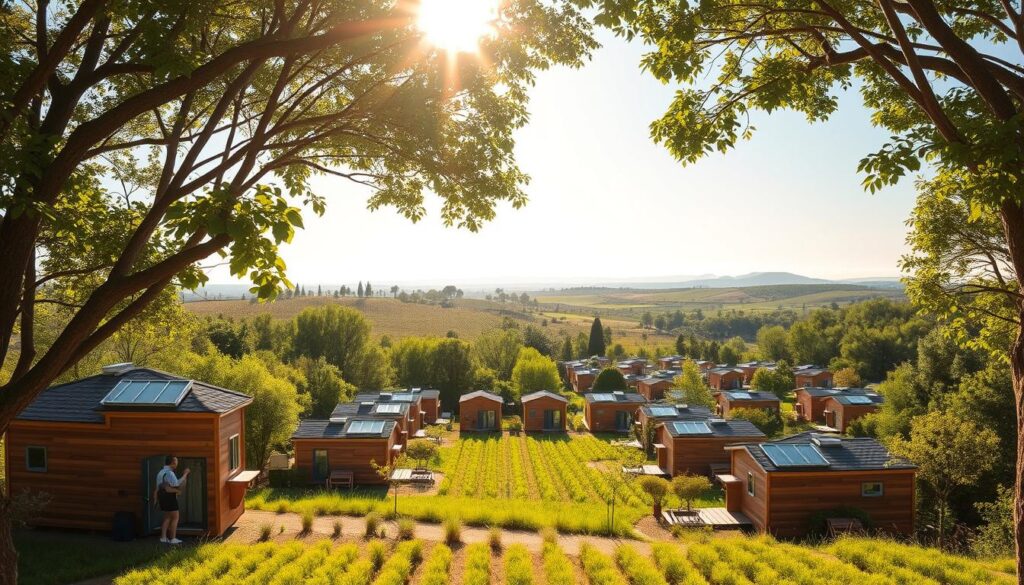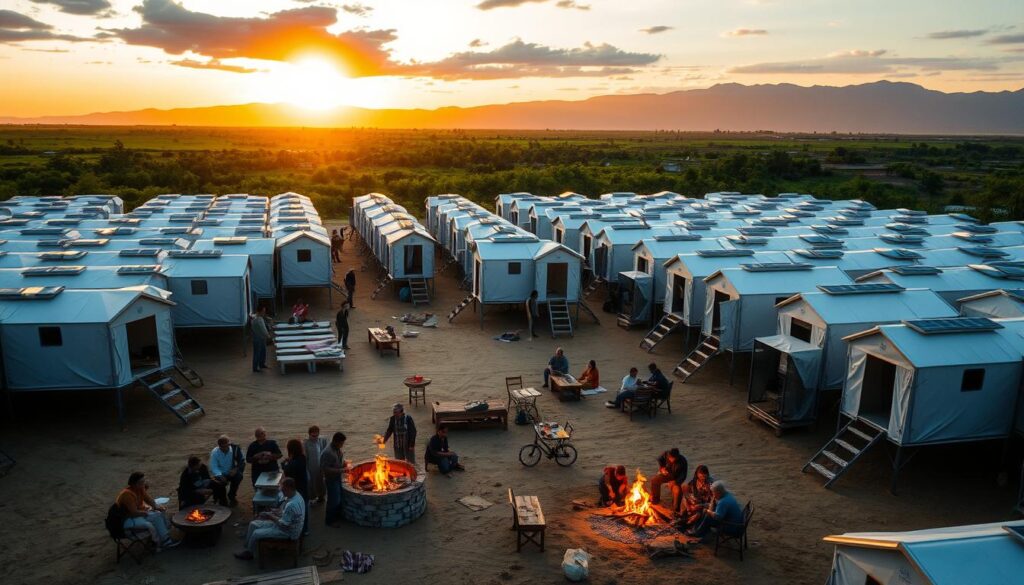Over 300 emergency tiny homes have been sent to help those who lost their homes to wildfires. These disasters are happening more often and getting worse. This shows we really need quick and good ways to house people in emergencies.
The Thompson Fire in California and the Bootleg Fire in Oregon are examples. They show how tiny home deployments help people find shelter fast. With wildfires getting more common, we need new ways to house people quickly.
Key Takeaways
- Rapid deployment of tiny homes is becoming a critical component of wildfire response efforts.
- The need for effective emergency housing solutions is on the rise due to increasing wildfire frequency and severity.
- Tiny homes offer a viable solution for providing immediate shelter to displaced residents.
- Examples like the Thompson Fire and Bootleg Fire demonstrate the impact of tiny home deployments.
- Innovative emergency housing solutions are crucial in addressing the growing threat of wildfires.
The Rising Threat of Wildfires in America
Wildfires in America are getting more common and severe. This is a big challenge for disaster response teams. The changing climate makes wildfires more likely, harming the environment, people, and property.
Recent Wildfire Statistics and Trends
Recent years have seen some of the most destructive wildfires in U.S. history. For example, the 2021 Dixie Fire in California burned over 963,000 acres. The 2022 New Mexico wildfires also caused a lot of damage, showing the danger wildfires pose to communities.
“The wildfire season is now year-round in many parts of the western United States,” said a spokesperson for the National Wildfire Coordinating Group. This highlights the need for better preparation and response strategies.
The Growing Need for Rapid Emergency Housing
Wildfires are happening more often and getting worse. This makes it urgent to have quick emergency housing. Traditional housing can’t keep up with disasters that happen fast, where people need shelter right away.
Tiny homes are becoming a good solution. They offer fast, safe, and respectful shelter. Deploying tiny homes in wildfires, like the Thompson Fire and Bootleg Fire, shows their value in disaster responses.
- Rapid deployment to affected areas
- Provision of safe and secure shelter
- Support for displaced communities
As wildfires become a bigger threat, the need for new emergency housing like tiny homes is clear.
Wildfire Response Accelerates Tiny Home Deployments

Wildfires are destroying the United States, making quick housing solutions crucial. Tiny homes are now key in disaster relief. They offer a safe place for those who lost their homes.
Evolution of Emergency Housing Solutions
Emergency housing has changed a lot lately. The old ways were slow and not very good. Tiny homes are fast, comfy, and green, making them perfect for disaster areas.
Innovative Features of Tiny Homes
- Integrated HEPA air filtration systems to improve indoor air quality
- Starlink connectivity for reliable communication and access to information
- Solar power integration for sustainable energy
Why Tiny Homes Are Ideal for Disaster Response
Tiny homes are great for disaster help. They’re small and easy to move. They also last long in tough weather.
| Feature | Benefit |
|---|---|
| Rapid Deployment | Quickly provides shelter for displaced individuals |
| Innovative Features | Enhances comfort and safety with integrated systems |
| Sustainable Energy | Reduces reliance on external power sources |
Using tiny homes in disasters is smart and green. As wildfires get worse, tiny homes will play a bigger part in helping communities.
California’s Thompson Fire Emergency Response
California’s Thompson Fire led to a quick emergency housing solution with tiny homes. The response was fast, focusing on giving shelter to those hit by the fire.
Overnight Deployment of 300 Prefabricated Units
Over 300 tiny homes were set up overnight in Oroville. This rapid deployment was crucial for those who lost their homes in the Thompson Fire.
Setting up so many homes quickly was a big challenge. It needed teamwork from government, manufacturers, and local groups. This success shows how well groups can work together in emergencies.
Fire-Resistant Design Features
The tiny homes used in the Thompson Fire response were made to resist fire. They have:
- Exterior finishes from fire-resistant materials
- Hardened glass windows to keep out embers
- Space around the units to prevent fire spread
These features make the homes safe for residents. They also lower the chance of fire reaching the tiny home areas.
Community Impact in Oroville
The tiny homes have greatly helped Oroville’s community. They provide safe housing, helping the community recover.
People are thankful for the quick response and the homes’ amenities. The effort is seen as a big help for those affected by the Thompson Fire.
Technological Innovations in Emergency Tiny Homes

Technology is making emergency tiny homes better and more sustainable. These homes now have cool features that improve life for those who need them.
Integrated HEPA Air Filtration Systems
HEPA air filtration systems are a big deal in emergency tiny homes. They keep the air clean and safe from harmful particles. This is great for people with breathing problems.
HEPA filters are especially useful near wildfires. They help make the air inside tiny homes as clean as it is outside.
Starlink Connectivity for Displaced Residents
Starlink connectivity is another big plus. It gives people fast and reliable internet. They can stay in touch with loved ones and keep up with work or school.
Starlink makes a big difference for those who have lost their homes. It helps them feel connected and keeps them informed.
Solar Power Integration
Solar power integration makes tiny homes more eco-friendly. They can run without needing power from outside. This cuts down on pollution.
Solar power is also a reliable energy source. It works even when there’s no power grid nearby.
In short, new tech in emergency tiny homes is changing disaster relief. Features like HEPA filters, Starlink, and solar power make these homes better. They help people recover faster and live more sustainably.
Oregon’s Bootleg Fire Relief Efforts
The Bootleg Fire in Oregon caused a lot of damage. It showed how important emergency housing is. Disaster recovery shelters were quickly set up to help those who lost their homes.
FEMA and Pallet Shelter Partnership
FEMA teamed up with Pallet Shelter to help. This partnership showed how public and private groups can work together. They quickly set up solar-powered tiny homes to give people shelter and a sense of community.
This partnership was key in providing emergency housing. They used their resources and knowledge to give high-quality, durable housing to those who needed it.
Solar-Powered Tiny Home Features
The tiny homes had special features. They had energy-efficient systems and durable construction materials. This made them good for the environment and strong against disasters.
- Integrated solar power systems for energy independence
- Durable, fire-resistant construction materials
- Efficient use of space to accommodate families and individuals
On-Site Mental Health Services Integration
The relief efforts also included mental health services. This was because being displaced can affect people’s minds. The services were part of the disaster relief to help with the emotional and psychological challenges.
Having mental health services in the tiny home communities was a big help. It showed that recovery is not just about a place to stay. It’s also about feeling okay again.
Logistics of Rapid Tiny Home Deployment
Getting tiny homes to disaster areas fast is key. It involves many steps, from moving them to setting them up. Everyone involved must work together well.
Transportation and Assembly Challenges
Getting tiny homes to disaster zones is hard. Roads might be damaged, making it tough to get there. For example, 300 units were moved to California’s Thompson Fire area with careful planning.
Setting up these homes quickly is another big challenge. They need to be put together fast. This requires skilled workers and the right tools.
Coordination Between Government Agencies and Manufacturers
Working together is crucial for quick tiny home deployment. Governments must figure out the need, buy the homes, and handle logistics. Meanwhile, manufacturers need to be ready to make and send them out fast.
“The partnership between government agencies and manufacturers is the backbone of successful disaster relief efforts. It ensures that the right resources are delivered to the right place at the right time.”
Training Local Teams for Installation
Training local teams is vital for a few reasons. It means they know the area well, which speeds up setup. Plus, they’re more familiar with local conditions.
| Training Aspect | Benefit |
|---|---|
| Local Infrastructure Knowledge | Faster Assembly |
| Specialized Skills | Improved Quality |
| Community Engagement | Better Coordination |
By focusing on these details, tiny homes can be a big help in emergencies. They provide quick, effective shelter to those in need.
Long-Term Impact and Future Applications
Tiny homes are changing how we respond to wildfires. They’re not just for emergency housing anymore. They’re also key for long-term recovery and rebuilding.
Transitioning from Emergency to Permanent Housing
One big plus of tiny homes in disaster response is they can become permanent homes. This gives people a stable place to live after a wildfire.
- Long-term affordability: Tiny homes cost less than regular houses. This makes them a good choice for those rebuilding their lives.
- Sustainability: Many tiny homes are eco-friendly. They help reduce environmental impact and meet the demand for green living.
- Community building: Tiny home villages can create a sense of community. They offer support networks that are vital in recovery.
Expanding the Model to Other Natural Disasters
The success of tiny homes in wildfire response has sparked interest in using them for other disasters. They’re flexible and can be quickly set up for various emergencies.
“The versatility of tiny homes allows them to be adapted to various disaster relief needs, providing a versatile tool in the disaster response toolkit.”
Cost-Effectiveness Compared to Traditional Relief Housing
Tiny homes are a cost-effective option compared to traditional relief housing. They’re cheaper because of efficient manufacturing, simpler construction, and lower transportation costs.
- Efficient manufacturing processes
- Simplified construction requirements
- Lower transportation costs due to their compact size
Studies show using tiny homes can save up to 30% compared to traditional methods. This makes them appealing to government agencies and disaster relief groups looking to stretch their budgets.
| Housing Type | Cost per Unit | Deployment Time |
|---|---|---|
| Tiny Homes | $30,000 | 1-2 weeks |
| Traditional Relief Housing | $45,000 | 4-6 weeks |
Conclusion
Wildfires in the US are getting worse, leading to more use of tiny homes as shelters. In places like California and Oregon, tiny homes quickly helped those who lost their homes.
Tiny homes are great for emergencies because they are fire-safe. They also have air filters and solar power. Plus, they help people stay in touch with loved ones through Starlink.
The success of tiny homes in helping during wildfires is big news for disaster relief. As more disasters happen, we’ll need more creative solutions like tiny homes. By using tiny homes, we can help communities recover faster.
